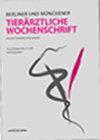急性兔吸虫病2例
IF 0.6
4区 农林科学
Q4 VETERINARY SCIENCES
Berliner und Munchener tierarztliche Wochenschrift
Pub Date : 2019-03-13
DOI:10.2376/0005-9366-18080
引用次数: 3
摘要
两只可食用睡鼠(Glis Glis)被发现死在一个院子里。尸检显示脾脏明显肿大,肝脏充血,肺部水肿出血。组织学上,两只动物的肝脏和脾脏均出现多灶性坏死,其中一只动物的肺部出现多灶性坏死。在急性兔热病的啮齿动物或狐猴中也可看到类似的结果。土拉菌病是一种由革兰氏阴性球菌弗朗西斯菌(F.)土拉菌引起的人畜共患病,可通过吸入受污染的气溶胶、摄入受污染的食物和水、污染粘膜和皮肤病变或节肢动物叮咬传播。土拉菌。在本病例中检测到与其他德国弗朗西斯菌分离株一样属于B.6支的全北极菌为病原体。可食用睡鼠通常栖息在落叶林地和混合林地,但也可以在花园、公园和果园等人造栖息地中找到。该物种经常进入建筑物,从而与人类密切接触。因此,由于食用睡鼠对感染的易感性,应牢记它们是德国和其他欧洲国家人类土拉菌病的可能来源。本文章由计算机程序翻译,如有差异,请以英文原文为准。
Glis glis – two cases of acute tularemia
Two edible dormice ( Glis glis) were found dead in a courtyard. At necropsy they showed marked enlargement of spleen, hyperemia of liver as well as edema and hemorrhages in the lungs. Histologically, multifocal necroses were found in liver and spleen of both animals and in the lungs of one animal. Similar findings can be seen in rodents or lagomorphs with acute tularemia. Tularemia is a zoonosis caused by the Gram negative coccobacillus Francisella (F.) tularensis which may be transmitted by inhalation of contaminated aerosols, ingestion of contaminated food and water, contamination of mucous membranes and skin leasons or arthropod bites. F. tularensis ssp. holarctica, assigned to clade B.6 like other German Francisella isolates, was detected as causative agent in the present cases. Edible dormice typically inhabit deciduous and mixed woodland, but can also be found in man-made habitats such as gardens, parks and orchards. The species often enters buildings, thus getting in close contact to humans. Therefore and due to their susceptibility of infection edible dormice should be kept in mind as possible source of human tularemia in Germany and other European countries.
求助全文
通过发布文献求助,成功后即可免费获取论文全文。
去求助
来源期刊
CiteScore
0.90
自引率
0.00%
发文量
0
审稿时长
18-36 weeks
期刊介绍:
The Berliner und Münchener Tierärztliche Wochenschrift is an open access, peer-reviewed journal that publishes contributions on all aspects of veterinary public health and its related subjects, such as epidemiology, bacteriology, virology, pathology, immunology, parasitology, and mycology. The journal publishes original research papers, review articles, case studies and short communications on farm animals, companion animals, equines, wild animals and laboratory animals. In addition, the editors regularly commission special issues on topics of major importance. The journal’s articles are published either in German or English and always include an abstract in the other language.

 求助内容:
求助内容: 应助结果提醒方式:
应助结果提醒方式:


